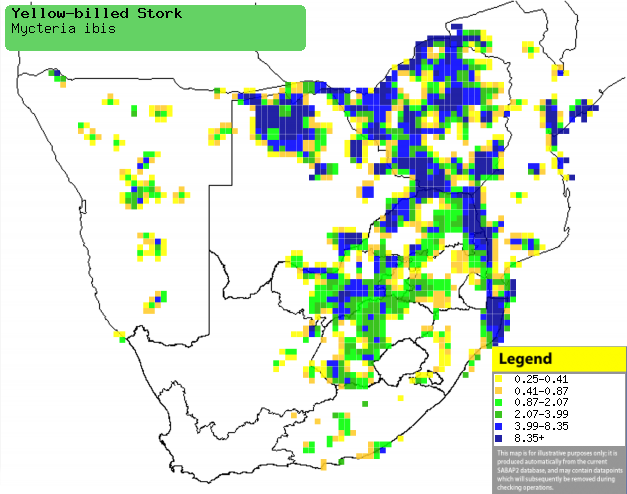|
Mycteria ibis (Yellow-billed
stork)
Nimmersat [Afrikaans]; Nepando
[Kwangali]; Mokotatsie (also applied to White stork) [South Sotho]; Afrikaanse
nimmerzat [Dutch]; Tantale ibis [French]; Nimmersatt [German];
Cegonha-de-bico-amarelo [Portuguese]
Life
> Eukaryotes >
Opisthokonta
> Metazoa (animals) >
Bilateria >
Deuterostomia > Chordata >
Craniata > Vertebrata (vertebrates) > Gnathostomata (jawed
vertebrates) > Teleostomi (teleost fish) > Osteichthyes (bony fish) > Class:
Sarcopterygii (lobe-finned
fish) > Stegocephalia (terrestrial
vertebrates) > Tetrapoda
(four-legged vertebrates) > Reptiliomorpha > Amniota >
Reptilia (reptiles) >
Romeriida > Diapsida > Archosauromorpha > Archosauria >
Dinosauria
(dinosaurs) > Saurischia > Theropoda (bipedal predatory dinosaurs) >
Coelurosauria > Maniraptora >Aves
(birds) > Order: Ciconiiformes > Family: Ciconiidae
Distribution and habitat
Occurs across much of sub-Saharan Africa. In southern
Africa it is common to locally abundant in
Mozambique, Zimbabwe, the eastern half of South Africa, northern and eastern
Botswana and Namibia (including the Caprivi Strip). It generally prefers
wetlands, such as pans, flood plains, marshes, streams, flooded grassland and
small pools, occasionally moving into mudflats and estuaries.
|
 |
|
Distribution of Yellow-billed stork in southern Africa,
based on statistical smoothing of the records from first SA Bird Atlas
Project (©
Animal Demography unit, University of
Cape Town; smoothing by Birgit Erni and Francesca Little). Colours range
from dark blue (most common) through to yellow (least common).
See here for the latest distribution
from the SABAP2. |
Predators and parasites
- Predators
- of adults
- Crocodylus niloticus (Nile crocodile)
- of eggs
Movements and migrations
Largely resident and nomadic, moving in
response to fish availability and water levels. Its numbers peak
from October-April in Mozambique, Zimbabwe, Botswana and Namibia,
suggesting that it might be an intra-African breeding migrant.
Food
It mainly eats fish, doing most of its foraging in shallow
water without vegetation, often wading with its bill half open and immersed in
the water while stirring up mud with its feet, catching any flushed by snapping
its bill shut. It may also follow Nile crocodiles (Crocodylus niloticus)
or Hippopotamuses (Hippopotamus amphibius), catching the animals they
disturb. The following food items have been recorded
in its diet:
- Vertebrates
- fish
- frogs
- Pyxicephalus adspersus (Giant bullfrog)
- Invertebrates
- aquatic insects
- worms
- crustaceans
Breeding
- Monogamous, breeding in colonies of 10-20, sometimes up to 50 nests per
tree, often alongside ibises,
herons,
African darters,
other storks (especially
Marabou storks),
African spoonbills
and/or cormorants.
- The nest is built by both sexes in about 7-10 days, consisting of a
platform of sticks with a shallow central cup lined with leaves, fine grass,
reeds and aquatic grasses. It is typically placed on top of a tree, such as
Acacia, Water fig (Ficus verruculosa) or Baobab (Adansonia
digitata), roughly 3-7 metres above ground or water.
- Egg-laying season is from July-March, peaking from August-October.
- It lays 2-4 eggs, which are incubated by both sexes for roughly 30 days.
- The chicks are brooded by both parents, constantly at first but more
intermittently later, while both adults provide food by regurgitation. They
take their first flight at about 35 days old, leaving the nest at about 55
days old and becoming independent five days or so later, although they may
return to the nest to roost up to approximately 90 days old.
Threats
Not threatened globally, although Near-threatened in
South Africa due to wetland disturbance and destruction..
References
-
Hockey PAR, Dean WRJ and Ryan PG 2005. Roberts
- Birds of southern Africa, VIIth ed. The Trustees of the John Voelcker
Bird Book Fund, Cape Town.
|
